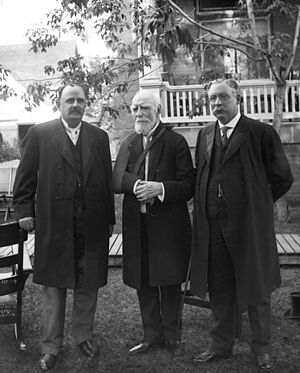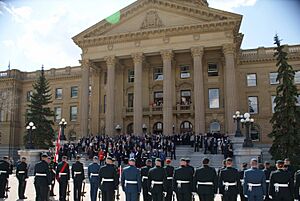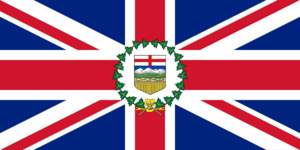Lieutenant Governor of Alberta facts for kids
Quick facts for kids Lieutenant Governor of Alberta |
|
|---|---|

Flag of the lieutenant governor
|
|

Emblem of the lieutenant governor
|
|
| Viceroy | |
| Seat | Edmonton, Alberta |
| Appointer | The governor general on the advice of the prime minister |
| Term length | At the governor general's pleasure |
| Formation | 1 September 1905 |
| First holder | George H. V. Bulyea |
The Lieutenant Governor of Alberta is a very important person in the province of Alberta. They are the official representative of the King or Queen of Canada. Think of them as the monarch's stand-in for Alberta.
Their main job is to carry out most of the King's duties in Alberta. This includes both official government tasks and special ceremonies.
The current Lieutenant Governor is Salma Lakhani. She became the 19th person to hold this role on August 26, 2020. She made history as the first South Asian and Muslim person to be a Lieutenant Governor in Canada.
Contents
What the Lieutenant Governor Does
The Lieutenant Governor has two main types of jobs: official government duties and ceremonial roles.
Government Duties
The Lieutenant Governor plays a key part in how Alberta is governed. They make sure that the government follows the rules and traditions. For example, they officially open new sessions of the provincial legislature. They also give "royal assent" to bills, which means they sign them into law after they are passed by the elected politicians.
Ceremonial Roles
The Lieutenant Governor also attends many special events and ceremonies. They are the Chancellor of the Alberta Order of Excellence. This means they help choose and welcome people who have done great things for Alberta into this special group.
They also present other awards and honours to deserving Albertans. These awards often celebrate community service, bravery, or achievements in different fields. The Lieutenant Governor hosts or attends hundreds of events each year. These events help connect the government with the people of Alberta.
Symbols of Office
When the Lieutenant Governor is at an event, you might see their special flag. This flag is blue and has Alberta's coat of arms on it, with a crown and ten gold maple leaves. The maple leaves stand for Canada's ten provinces.
In Alberta, the Lieutenant Governor is second only to the King or Queen in terms of official importance. They come before even other members of the Canadian royal family or the Governor General of Canada.
History of the Office

The job of Lieutenant Governor of Alberta started in 1905. This was when Alberta officially became a province of Canada. Before that, there was a similar role for the larger North-West Territories.
Since 1905, 19 different people have served as Lieutenant Governor. Some of them were the first to achieve certain milestones. For example, Norman Kwong was the first Asian-Canadian Lieutenant Governor. Helen Hunley was the first woman to hold the position in Alberta.
The shortest time someone served was Philip Primrose, who was in office for only a few months in 1936-1937. The longest-serving was John C. Bowen, from 1937 to 1950. In 1956, Lieutenant Governor John J. Bowlen was the first provincial representative in Canada to meet directly with the Canadian monarch. This started a tradition that continues today.
Important Moments
There have been times when the Lieutenant Governor had to make tough decisions. In 1937, Lieutenant Governor John Bowen stopped three bills from becoming law. Two of these bills would have given the province control over banks. The third bill, called the Accurate News and Information Act, would have forced newspapers to print government responses to stories.
These bills were later found to be against Canada's laws by the highest courts. Because Lieutenant Governor Bowen stopped them, the Premier at the time was very upset. He closed the official residence of the Lieutenant Governor and took away their staff and car.
Much later, in the early 2000s, Lieutenant Governor Lois Hole thought about stopping a bill about health care. She wanted to talk to the Premier about it. While she considered it, she eventually allowed the bill to pass. These examples show how the Lieutenant Governor can play an important role in making sure laws are fair and follow the constitution.
Former Residences
The Lieutenant Governor does not currently have an official home provided by the government.
In the past, Lieutenant Governors lived in special houses. From 1913 to 1938, they lived at Government House. This building is now used as the Alberta Government Conference Centre.

Another residence was used from 1966 to 2004 at 58 St. George's Crescent in Westmount, Edmonton. That house was taken down in 2005. Lieutenant Governor John J. Bowlen also lived in a house built for him from 1950 to 1959.
See also
- Monarchy in the Canadian provinces
- Government of Alberta




